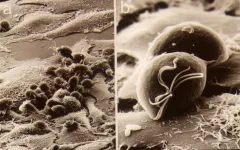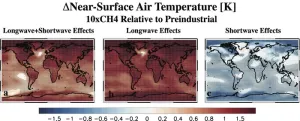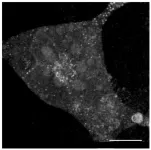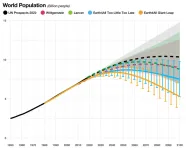(Press-News.org) INDIANAPOLIS – The burden of the pandemic has disproportionately affected socially vulnerable populations. One of the first studies to look at the intersection of social vulnerability with COVID-19 vaccine utilization and effectiveness has found that while vaccination rates have varied substantially between socially vulnerable and communities that are not socially vulnerable, there has been no difference in vaccine effectiveness between those who are socially vulnerable and those who are not.
“We found that protection against emergency room and urgent care center visits, hospitalization and death conveyed by a COVID-19 mRNA vaccination did not vary by social vulnerability,” said study co-author Brian Dixon, PhD, MPA. “But because social vulnerability did play a role in whether individuals are vaccinated or not –- and socially vulnerable communities have lesser vaccine coverage –- socially vulnerable individuals and their communities are bearing a larger burden during the pandemic. They are having poorer outcomes as they are less likely to be vaccinated.”
In the study, conducted by the U.S. Centers for Disease Control and Prevention’s VISION Network, social vulnerability was calculated using the CDC and Agency for Toxic Substances and Disease Registry Social Vulnerability Index, which captures 15 attributes across four themes:
socioeconomic status
household composition and disability
minority status and language
housing type and transportation
Calculation of the social vulnerability index produces a number that can be used to determine how vulnerable a community might be in time of crisis, such as a natural disaster or a pandemic.
This study evaluated electronic health record (EHR) data and immunization records from adults age 18 and older.
“Socially vulnerable individuals may live in densely populated buildings and neighborhoods, travel via crowded public transportation and often hold jobs that are not conducive to remote work. So, they are more susceptible to catching COVID,” said co-author Katie Allen, B.S., a data scientist with Regenstrief Institute. “And they may not have the resources to seek medical care when they are getting sick, leading to adverse medical outcomes.”
“Initial COVID-19 vaccination coverage remains lower in communities with higher social vulnerability and booster rates are even lower,” said Dr. Dixon. “This study shows the need to focus public health efforts on vaccine coverage as well as vaccine effectiveness.”
The VISION Network is a research network that evaluates COVID-19 vaccine effectiveness across diverse populations and geographic areas. VISION includes seven organizations that contribute and analyze data from U.S. healthcare systems to learn more about COVID-19. In addition to Regenstrief Institute, other members are Columbia University Irving Medical Center, HealthPartners, Intermountain Healthcare, Kaiser Permanente Northern California, Kaiser Permanente Northwest and University of Colorado.
“Relationships between social vulnerability and COVID-19 vaccination coverage and vaccine effectiveness” is published in the peer-reviewed journal, Clinical Infectious Diseases. Regenstrief authors, in addition to Dr. Dixon and Ms. Allen, are Shaun Grannis, M.D., M.S.; William F. Fadel, PhD; Nimish Ramesh Valvi, DrPH, MBBS; and former Institute president and current affiliated scientist Peter Embi, M.D.
Authors and affiliations
Alexandra F Dalton 1, Zachary A Weber 2, Katie S Allen 3 4, Edward Stenehjem 5, Stephanie A Irving 6, Talia L Spark 2, Katherine Adams 1, Ousseny Zerbo 7, Victoria Lazariu 2, Brian E Dixon 3 4, Kristin Dascomb 5, Emily Hartmann 8, Anupam B Kharbanda 9, Toan C Ong 10, Malini B DeSilva 11, Maura Beaton 12, Manjusha Gaglani 13 14, Palak Patel 1, Allison L Naleway 6, Magdalene N Sam Kish 2, Shaun J Grannis 3 4, Nancy Grisel 5, Chantel Sloan-Aagard 8 15, Suchitra Rao 10, Chandni Raiyani 13, Monica Dickerson 1, Elizabeth Bassett 2, William F Fadel 3 4, Julie Arndorfer 5, Juan Nanez 8, Michelle A Barron 10, Gabriela Vazquez-Benitez 11, I-Chia Liao 13, Eric P Griggs 1, Sarah E Reese 2, Nimish R Valvi 3, Kempapura Murthy 13, Elizabeth A K Rowley 2, Peter J Embi 3 16, Sarah Ball 2, Ruth Link-Gelles 1, Mark W Tenforde 1
1Centers for Disease Control and Prevention COVID-19 Response Team, Atlanta, Georgia, USA.
2Westat, Rockville, Maryland, USA.
3Center for Biomedical Informatics, Regenstrief Institute, Indianapolis, Indiana, USA.
4Fairbanks School of Public Health, Indiana University, Indianapolis, Indiana, USA.
5Division of Infectious Diseases and Clinical Epidemiology, Intermountain Healthcare, Salt Lake City, Utah, USA.
6Center for Health Research, Kaiser Permanente Northwest, Portland, Oregon, USA.
7Kaiser Permanente Vaccine Study Center, Kaiser Permanente Northern California Division of Research, Oakland, California, USA.
8Paso del Norte Health Information Exchange (PHIX), El Paso, Texas, USA.
9Children's Minnesota, Minneapolis, Minnesota, USA.
10School of Medicine, University of Colorado Anschutz Medical Campus, Aurora, Colorado, USA.
11HealthPartners Institute, Minneapolis, Minnesota, USA.
12Department of Biomedical Informatics, Columbia University Irving Medical Center, New York, New York, USA.
13Baylor Scott & White Health, Temple, Texas, USA.
14Texas A&M University College of Medicine, Temple, Texas, USA.
15Brigham Young University Department of Public Health, Provo, Utah, USA.
16Vanderbilt University Medical Center, Nashville, Tennessee, USA.
About Brian E. Dixon, PhD, MPA
In addition to his roles as interim director of the Regenstrief Institute’s Clem McDonald Center for Biomedical Informatics and director of public health informatics for Regenstrief Institute and Indiana University Richard M. Fairbanks School of Public Health, Brian E. Dixon, PhD, MPA is a professor of epidemiology at the Fairbanks School of Public Health. He is also an affiliate scientist at the U.S. Department of Veterans Affairs Health Services Research and Development Center for Health Information and Communication, Richard L. Roudebush VA Medical Center.
About Katie Allen
Katie Allen is a data scientist at Regenstrief Institute, adjunct faculty at Indiana University Richard M. Fairbanks School of Public Health (FSPH) and a doctoral student in health policy and management at FSPH. She has experience as a senior program manager in health services research at the Richard L. Roudebush VA Medical Center and as a program manager for LOINC® from Regenstrief (short for Logical Observation Identifiers Names and Codes), a worldwide healthcare data interoperability standard used in nearly every country in the world.
About Regenstrief Institute
Founded in 1969 in Indianapolis, the Regenstrief Institute is a local, national and global leader dedicated to a world where better information empowers people to end disease and realize true health. A key research partner to Indiana University, Regenstrief and its research scientists are responsible for a growing number of major healthcare innovations and studies. Examples range from the development of global health information technology standards that enable the use and interoperability of electronic health records to improving patient-physician communications, to creating models of care that inform practice and improve the lives of patients around the globe.
Sam Regenstrief, a nationally successful entrepreneur from Connersville, Indiana, founded the institute with the goal of making healthcare more efficient and accessible for everyone. His vision continues to guide the institute’s research mission.
About the Richard M. Fairbanks School of Public Health
Located on the IUPUI and Fort Wayne campuses, the Richard M. Fairbanks School of Public Health is committed to advancing the public’s health and well-being through education, innovation and leadership. The Fairbanks School of Public Health is known for its expertise in biostatistics, epidemiology, cancer research, community health, environmental public health, global health, health policy and health services administration.
END
Socially vulnerable carry disproportionate COVID burden due to lower likelihood of vaccination not vaccine effectiveness
2023-03-27
ELSE PRESS RELEASES FROM THIS DATE:
Positive experiences in close relationships are associated with better physical health, new research suggests
2023-03-27
Social relationships influence physical health, but questions remain about the nature of this connection. New research in Social Psychological and Personality Science suggests that the way you feel about your close relationships may be affecting the way your body functions.
Previous smaller-scale studies have examined the connection between relationship conflict or satisfaction with stress levels and blood pressure. The new research examines the effects of positive and negative relationship experiences on the body, as well as how these experiences and health outcomes change ...
Research may speed identification of patients who need liver transplants
2023-03-27
Research findings from Rutgers, the University of Michigan, the University of Texas Southwestern, and the Medical University of South Carolina could save lives by enabling faster and more accurate identification of hospitalized patients who need liver transplants or are likely to recover.
Retrospective analysis of blood samples and medical records from 270 patients admitted to the hospital with acute liver failure (ALF) found that concentrations of a short-lived but abundant serum protein called carbamoyl phosphate synthetase 1 (CPS1) helped predict which patients survive or die without a transplant.
“We still need to validate these results in more patients to ...
Finger-prick test developed for ‘trich’ a common, undiagnosed STI
2023-03-27
PULLMAN, Wash. – A quick, affordable diagnostic test developed by a Washington State University researcher may help curb one of the most prevalent but least discussed sexually transmitted infections.
More common than chlamydia or gonorrhea, Trichomonas vaginalis, also known as trich, causes no symptoms in about 70% of those infected. Even when asymptomatic, trich is linked to a host of bad health outcomes, including increased susceptibility to HIV, prostate cancer in men and infertility and pregnancy complications in women.
Trich is easily ...
Surprise effect: Methane cools even as it heats
2023-03-27
Most climate models do not yet account for a new UC Riverside discovery: methane traps a great deal of heat in Earth’s atmosphere, but also creates cooling clouds that offset 30% of the heat.
Greenhouse gases like methane create a kind of blanket in the atmosphere, trapping heat from Earth’s surface, called longwave energy, and preventing it from radiating out into space. This makes the planet hotter.
“A blanket doesn’t create heat, unless it’s electric. You feel warm because ...
A puff of air could deliver your next vaccine (video)
2023-03-27
INDIANAPOLIS, March 27, 2023 — Nobody likes needles, but they’re necessary for delivering many vaccines and biologics into the body. But what if those could be puffed through the skin instead, with just a little pressure, like being hit in the arm with a foam toy? Today, scientists report steps toward making that a reality. Using powdered vaccines that don’t require refrigeration and a system driven by compressed gas, their “MOF-Jet” could easily deliver therapeutics against cancer and other diseases in a relatively painless way.
The researchers will present their results at the spring meeting of the American Chemical Society (ACS). ACS ...
Human cells help researchers understand squid camouflage
2023-03-27
INDIANAPOLIS, March 27, 2023 — Squids and octopuses are masters of camouflage, blending into their environment to evade predators or surprise prey. Some aspects of how these cephalopods become reversibly transparent are still “unclear,” largely because researchers can’t culture cephalopod skin cells in the lab. Today, however, researchers report that they have replicated the tunable transparency of some squid skin cells in mammalian cells, which can be cultured. The work could not only shed light on basic squid biology, but ...
Genetic tests unexpectedly find genes linked to heart disease — now what?
2023-03-27
Statement Highlights:
As health care professionals, researchers and consumers increasingly use genetic testing, they are uncovering incidental genetic abnormalities, or variants, that are associated with cardiovascular diseases.
The statement writing committee cautions that incidentally identified single gene variants may or may not be risk factors for disease, so it is important to interpret them correctly and cautiously.
The new scientific statement offers a framework to support health care professionals in appropriately assessing individual genetic variants, communicating findings with patients and families, and, when ...
Biochar and energy from pyrolysis can pave the way for carbon-neutral agriculture in China
2023-03-27
Since the Paris Agreement to combat global warming was reached in 2015, many countries have committed to becoming climate neutral, i.e., achieving net-zero greenhouse gas emissions. The world's largest agricultural country, China, is also committed to join the green transition. As the largest agricultural country, China is also the world's biggest emitter of greenhouse gases, yet it has set itself a target of achieving carbon neutrality by 2060.
According to Professor and Head of Land-CRAFT at Department of Agroecology at Aarhus University Klaus Butterbach-Bahl, this places huge demands on agricultural systems: "Agriculture in China accounts ...
Two striking new species of carnivorous plants discovered in the Andes of Ecuador
2023-03-27
A team of botanists from Ecuador, Germany, and the United States has described two new species of carnivorous plants with striking appearance. They are part of the butterworts (genus Pinguicula), a group of flowering plants with about 115 species that can catch and digest small insects with their sticky leaves. Whereas the majority of butterwort species is distributed in the northern hemisphere, these new species were discovered in the high Andes of southern Ecuador, close to the border with Peru.
Carnivorous plants use animals (usually small insects) as an additional source of nutrients ...
Global population could peak below 9 billion in 2050s
2023-03-27
The new projection is significantly lower than several prominent population estimates, including those of the United Nations. The researchers go further to say that if the world takes a “Giant Leap” in investment in economic development, education and health then global population could peak at 8.5 billion people by the middle of the century.
The new projections by researchers from the Earth4All initiative for the Global Challenges Foundation is published as a working paper People and Planet, 21st Century Sustainable Population Scenarios and Possible Living Standards Within Planetary Boundaries.
The team used a new system ...





